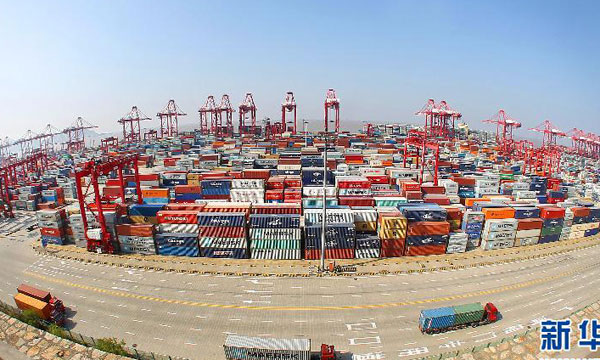

 |
| File photo |
BEIJING, April 21 --Three new free trade zones (FTZ) began official operation on Tuesday as China seeks to draw more international commerce.
The new zones were established 18 months after the first FTZ was unveiled in the financial hub Shanghai, which was designed to help streamline the overloaded administrative approval system and encourage innovation and internationalization.
Officials expect the new FTZs in Tianjin, Guangdong and Fujian will boost economic reform, promote trade and facilitate investment in new areas as the world's second largest economy moves away from an unsustainable export-dependent model.
Provincial-level officials attended the launching ceremony at the three zones Tuesday, when dozens of business licenses were ceremonially granted to registered enterprises.
Some businesses have already experienced the increased efficiency of working in the new zones.
Liu Qiya, the chief financial official with Tuwei Tongli Electrical Technology based in Xiamen, an open coastal city of Fujian, said his company was granted an operational license for the zone just three days after the application was submitted. The same procedure in other parts of the province could take weeks.
Antonio Fossanti, CEO of the Italian RDS, said the reason his retail company chose to operate in the Tianjin zone is the one-stop solution of problems concerning policy, customs, trade and marketing.
According to a detailed plan released on Monday, the new zones will be based on the Shanghai FTZ but catered to utilize their geographical locations.
By its first anniversary, the Shanghai zone had seen nearly 12,000 registered enterprises lured by a better trade and investment environment.
The Tianjin zone aims to better integrate the northern municipality with Beijing and Hebei Province. It will prioritize modern service industries, including shipping, culture and equipment manufacturing.
The Guangdong zone will deepen economic cooperation between the mainland and neighboring special administrative regions Hong Kong and Macao. It will have three bases in the cities of Guangzhou, Shenzhen and Zhuhai.
The Fujian zone will focus on developing economic cooperation between the mainland and Taiwan. It will cover three areas in Xiamen, Fuzhou and Pingtan, a new industrial park targeting investment from Taiwan.
The Shanghai zone, which has been more than quadrupled in size since it was established, will continue to strive for "the greatest openness" to facilitate investment and trade with currency convertibility and a sound legal environment. It will also further open its service and manufacturing industries.
All zones must adhere to the negative list, which details 122 prohibited or restricted areas for foreign investment, ranging from Internet news services, production of radio and television programs to non-ferrous metal mining. This number has been reduced from 139.
Foreign investors will be subject to the same rules and regulations for new investment as domestic firms.
Experts believe that these fresh zones are strategically important for the "belt and road" initiative, which aims to better connect Asia, Europe and Africa, as a way to boost investment and consumption.
Shao Yu, Shanghai-based chief economist of the Orient Securities Co.,Ltd., said the four FTZs will be crucial "supporting points" for the belt and road initiative.
"More opening-up moves are needed in regions such as southwestern Yunnan and Tibet for the new strategic layout," he said.
Wang Shouwen, assistant minister of commerce, said the new zones will not just copy the Shanghai zone but also break fresh ground in areas such as investment administration, trade regulation and financial systems.
The replication of successful reform measures is a common strategy in the reform and opening-up drive. The Shenzhen Special Economic Zone, founded in 1980, has been rolled out along the entire east coast over the past three decades.
That zone allowed foreign investment to develop the manufacturing industry, a driving force behind the economic boom of previous decades.
FTZ fever has caught the attention of officials across the country, with many pushing for their regions to be included in the next batch of FTZs.
However, observers warn that the central government must ensure that the FTZs are used to pioneer reform measures, and that their policies are correctly implemented.
Foreign business groups have said that the Shanghai zone brought improvements but they expected "more tangible benefits" of financial reforms, such as full convertibility of the yuan.
 J-11 fighters in air exercise
J-11 fighters in air exercise Beauties dancing on the rings
Beauties dancing on the rings Attendants-to-be join Mr. & Miss Campus Contest
Attendants-to-be join Mr. & Miss Campus Contest Beijing's toughest anti-smoking law takes effect
Beijing's toughest anti-smoking law takes effect Family lives in cave for about 50 years in SW China
Family lives in cave for about 50 years in SW China PLA soldiers operating vehicle-mounted guns in drill
PLA soldiers operating vehicle-mounted guns in drill Blind carpenter in E China's Jiangxi
Blind carpenter in E China's Jiangxi China hosts overseas disaster relief exercise for the first time
China hosts overseas disaster relief exercise for the first time 20 pairs of twins who will become flight attendants in Sichuan
20 pairs of twins who will become flight attendants in Sichuan Obama is sowing discontent in S.China Sea
Obama is sowing discontent in S.China Sea Rescuers work through night to reach cruise ship survivors
Rescuers work through night to reach cruise ship survivors Driving through limbo
Driving through limbo Facing down MERS
Facing down MERSDay|Week